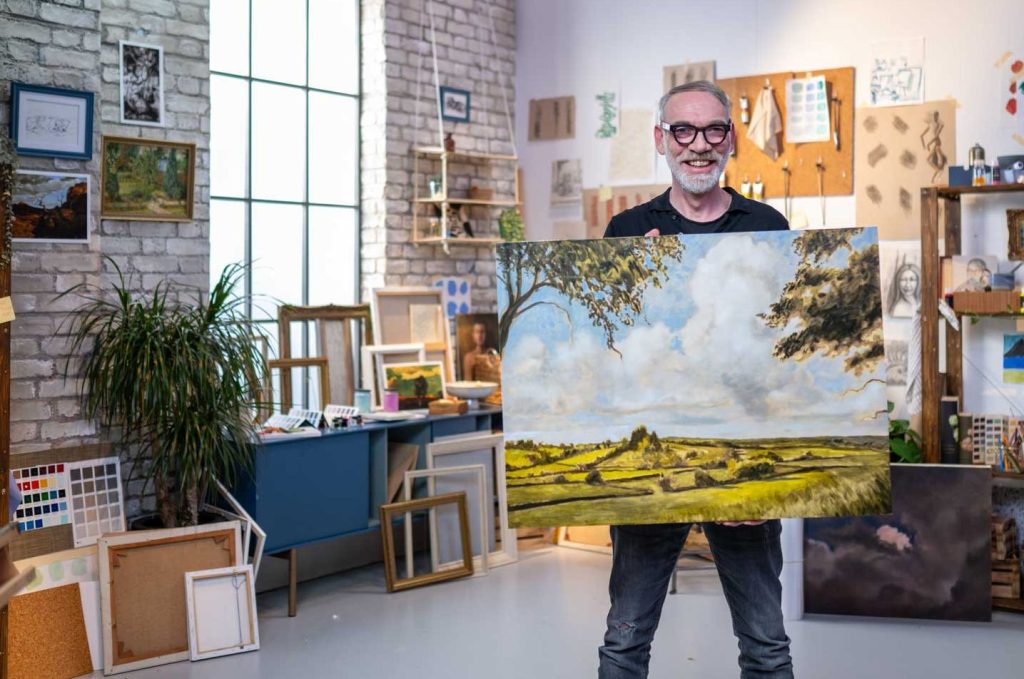COMPOSITION IN LANDSCAPE –
Finn Campbell-Notman

Reference Image
Materials

Canvas
Set of Oils
Selection of Brushes
Ruler & Pencil (For gridding)
Palette
Solvent
Find these items at cassart.co.uk
Preparing your canvas
Begin with a pre-primed canvas of a warm ground. Using the reference photo provided, grid your canvas with eight squares across, and six squares down.
Begin to sketch the outline of the key features of the image. These are the trees, hills, bushes and the clouds.
Expect to spend around 3-4 hours on the gridding process—though it may feel time-consuming, it will make the painting stage easier.
While you can use the reference image for this exercise, eventually try creating your own landscape based on a photograph you’ve taken. You can adjust the composition and add gridlines digitally or on paper.

Sketching your composition in paint
Squeeze out some raw umber onto your palette. Using a thin round brush, loosely paint over your pencil compositional sketch. Ensure that the mix is quite thin, using a solvent, as this is only an under-layer.
Begin by painting the tree to the left of your canvas as this helps to frame the view. Your aim is to make it feel that you are looking into a landscape rather than looking at a painting.
Work around the canvas and block in anything else that helps frame the view.
Triangular shapes in a composition can guide how the landscape elements are arranged. Look for triangular groupings (e.g., mountains, trees, or other objects) in the painting and block them in. They will create a stable and pleasing structure that guides the viewer’s gaze.
Adding to your compositional sketch
Once you have a painting sketch that includes the key focal points, it’s time to add the secondary part of the composition; the receding fields.
The fields lead your eye across the canvas. Take time to paint them properly.
Try to assess the composition as you go. Look for smaller lines that lead your eyes across the canvas and add them.


Blocking in the sky
Once you have painted the structural elements of the composition, it is time to paint in the larger masses in the negative spaces i.e. the blue sky.
You should block in the sky with a mix of blue paint but don’t worry about getting the tonal values correct. You can work on tone at a later stage. At this point, focus on blocking your composition in terms of colour.
Once you have blocked in your sky, look at your reference image again. Are there any other branches or shapes that you can paint using the Burnt Umber that will help the composition? If so, add them in.
Top tip – at every point, think about what you can add to help draw the viewer’s eye around the canvas. You should be thinking about composition throughout the whole process.
Blocking in colours
On your palette, mix a dark grey colour for the clouds. By painting from dark to light, you will start with the shadow of the clouds. Don’t worry if the colours are not perfect. At this point, you are still blocking in.
Using a large, soft brush, move on to paint the white of the clouds. Again, it does not have to be perfect, you want to get a sense of where the light is hitting the clouds.
Mix up a green to paint the fields. The green does not need to be an exact match, however notice where the sun is hitting the field and how the shades of green differ. Again, you are blocking in the tones at this point.

Mix a darker green for the leaves on the trees. Take a larger brush and dash in leaf shapes.
Continue adding colour to the rest of your canvas.

Adding tones
With your colours blocked in, you can start to play with the correct tones and apply them to relevant areas of the canvas. Take your time when mixing, you want to get the tones right.
Top tip – The field to the left of the composition is an intense green but that is the only area where the tone will be so intense. All other colours will be lighter.
Brush strokes
When you have covered your canvas in the correct colours and tones it is time to think about adding detail and complimenting the composition with the use of brushstrokes.
Add directional brushstrokes to the trees, clouds and sky. Play around with the marks you are making.
Keep refining until your work is complete.

By using this website you agree to our Privacy Policy.



